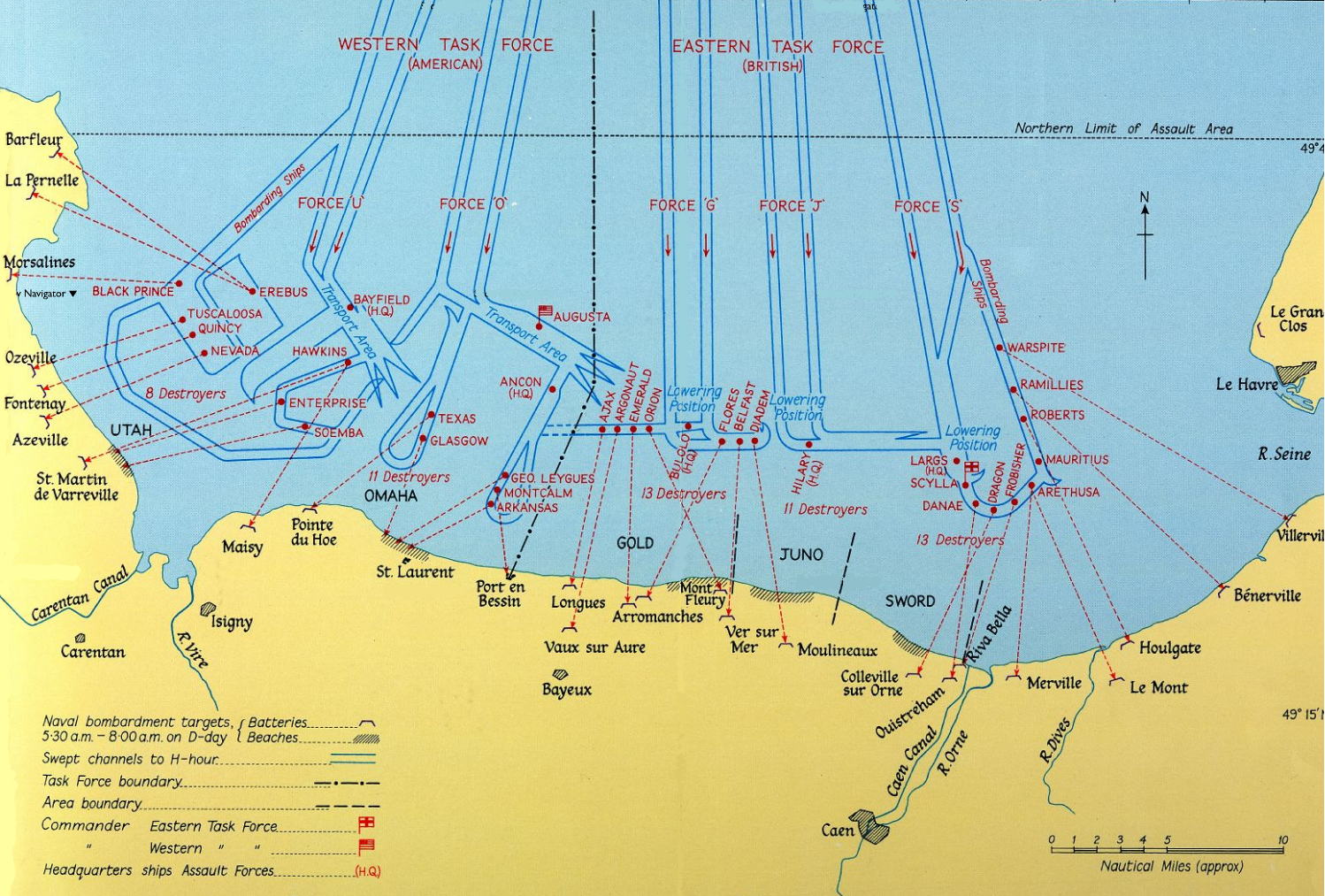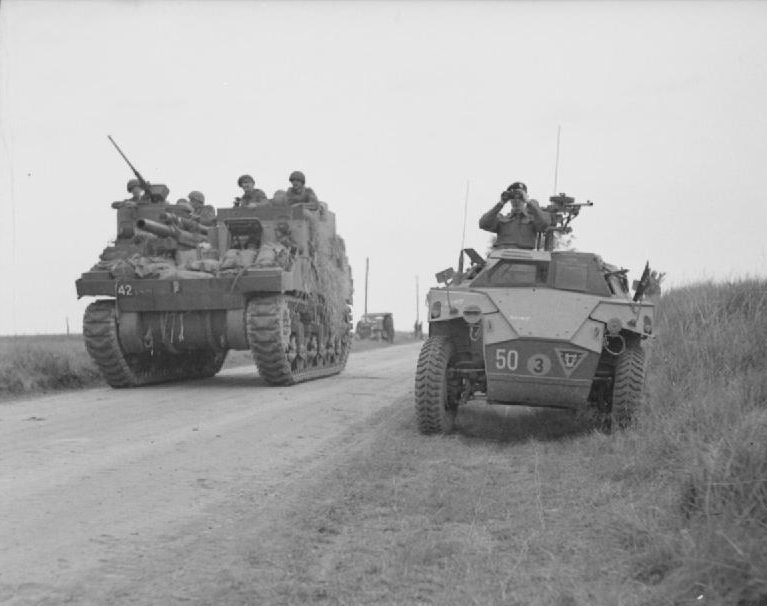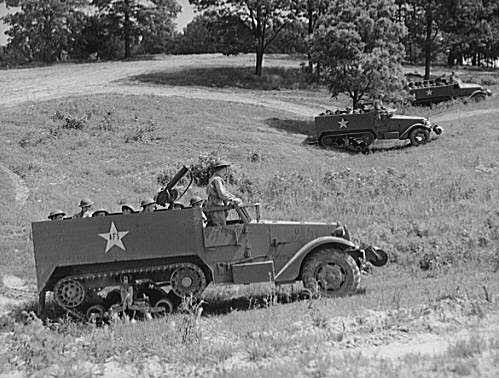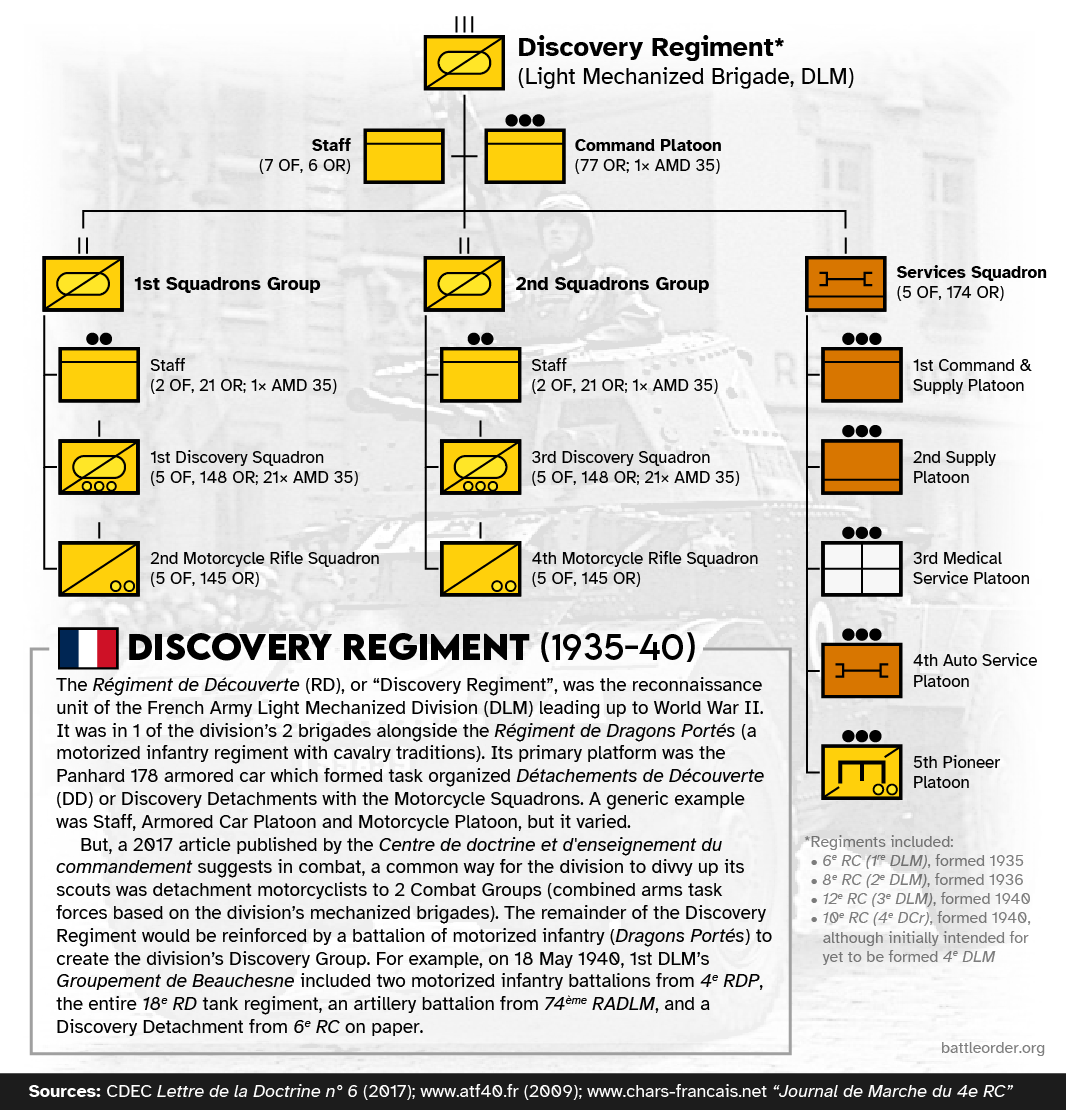|
2nd Armoured Division (France)
The French 2nd Armored Division (french: link=no, 2e Division Blindée, 2e DB), commanded by General Philippe Leclerc, fought during the final phases of World War II in the Western Front for the liberation of France. The division was formed around a core of units that had fought in the North African campaign, and re-organized into a light armored division in 1943. The division embarked in April 1944 and shipped to various ports in Britain. On 29 July 1944, bound for France, the division embarked at Southampton. During combat in 1944, the division liberated Paris, defeated a Panzer brigade during the armored clashes in Lorraine, forced the Saverne Gap and liberated Strasbourg. After taking part in the Battle of the Colmar Pocket, the division was moved west and assaulted the German-held Atlantic port of Royan, before recrossing France in April 1945 and participating in the final fighting in southern Germany, even going first into Hitler's "Eagle's Nest" (Americans captured the tow ... [...More Info...] [...Related Items...] OR: [Wikipedia] [Google] [Baidu] |
Cross Of Lorraine
The Cross of Lorraine (french: Croix de Lorraine, link=no), known as the Cross of Anjou in the 16th century, is a heraldic two-barred cross, consisting of a vertical line crossed by two shorter horizontal bars. In most renditions, the horizontal bars are "graded" with the upper bar being the shorter, though variations with the bars of equal length are also seen. The ''Lorraine'' name has come to signify several cross variations, including the patriarchal cross with its bars near the top. Design The Cross of Lorraine consists of one vertical and two horizontal bars. In most renditions, the horizontal bars are "graded" with the upper bar being the shorter, though variations with the bars of equal length are also seen. History The Cross of Lorraine came from the Kingdom of Hungary to the Duchy of Lorraine. In Hungary, Béla III was the first monarch to use the two-barred cross as the symbol of royal power in the late 12th century. He probably adopted it from the Byzantine Em ... [...More Info...] [...Related Items...] OR: [Wikipedia] [Google] [Baidu] |
Pierre Milza
Pierre Milza (16 April 193228 February 2018) was a French historian. His work focused mainly on the history of Italy, the history of Italian immigration to France and the history of fascism, of which he was a recognized specialist. He was professor emeritus at the Paris Institute of Political Studies (Sciences Po), where he taught contemporary history. Pierre Milza is notably the author of ''Voyage en Italie'', or "History of Italy", as well as of biographies of Mussolini, Napoleon III and Garibaldi. Early life Milza was a second-generation Italian immigrant, born in Paris, France to Italian parents. His father, Olivier Milza, was born near Parma in Italy. His status as an immigrant motivated his studies in Italian history and Italian-French immigration. Milza first visited Italy at 16, learned Italian and began to study history. Distinctions * Knight of the Order of Arts and Letters * 1994: Grand Officer of the Order of Merit of the Italian Republic * 2008: Commander of ... [...More Info...] [...Related Items...] OR: [Wikipedia] [Google] [Baidu] |
Utah Beach
Utah, commonly known as Utah Beach, was the code name for one of the five sectors of the Allied invasion of German-occupied France in the Normandy landings on June 6, 1944 (D-Day), during World War II. The westernmost of the five code-named landing beaches in Normandy, Utah is on the Cotentin Peninsula, west of the mouths of the Douve and Vire rivers. Amphibious landings at Utah were undertaken by United States Army troops, with sea transport, mine sweeping, and a naval bombardment force provided by the United States Navy and Coast Guard as well as elements from the British, Dutch and other Allied navies. The objective at Utah was to secure a beachhead on the Cotentin Peninsula, the location of important port facilities at Cherbourg. The amphibious assault, primarily by the US 4th Infantry Division and 70th Tank Battalion, was supported by airborne landings of the 82nd and 101st Airborne Division. The intention was to rapidly seal off the Cotentin Peninsula, prevent the G ... [...More Info...] [...Related Items...] OR: [Wikipedia] [Google] [Baidu] |
Howitzer Motor Carriage M8
The 75 mm Howitzer Motor Carriage M8 was a self-propelled howitzer vehicle of the United States in use during World War II. It was developed on the chassis of the M5 Stuart tank and was equipped with a M116 howitzer in an M7 mount. Development and design Prototypes Experiments with a close-support version of the M3 Stuart began with the T18 Howitzer Motor Carriage. This essentially combined an M3 light tank chassis with the gun mount of a M3 Grant medium tank mounting the much smaller 75mm pack howitzer. This produced a tall design with the gun well forward, which led to the tank being nose-heavy. They also found the fighting compartment was too cramped and the cut-down sides provided no protection to the crew for shots anywhere but the front. The T18 was cancelled in 1942 in favor of a new design, the T41. This moved to the updated M5 chassis, differing from the M3 mostly in its engine, while introducing a new fighting compartment with a well-sloped front that provided more ... [...More Info...] [...Related Items...] OR: [Wikipedia] [Google] [Baidu] |
M7 Priest
The 105 mm Howitzer Motor Carriage M7 was an American self-propelled gun vehicle produced during World War II. It was given the official service name 105 mm Self Propelled Gun, Priest by the British Army, due to the pulpit-like machine gun ring, and following on from the Bishop and the contemporary Deacon self-propelled guns. Design and development During the early stages of World War II, US Army observers realized that they would need a self-propelled artillery vehicle with sufficient firepower to support armored operations. Lessons learned with half-tracks (such as the T19 Howitzer Motor Carriage (HMC) with a 105 mm howitzer on the M3 Half-track chassis) also showed that this vehicle would have to be armored and fully tracked. It was decided to use the M3 Lee chassis as the basis for this new vehicle design, named T32.Bishop, p. 120. The pilot vehicles used the M3 chassis with an open-topped superstructure, mounting an M2A1 105 mm howitzer, with a mach ... [...More Info...] [...Related Items...] OR: [Wikipedia] [Google] [Baidu] |
3rd Marine Artillery Regiment
The 3rd Marine Artillery Regiment (french: 3e Régiment d'Artillerie de Marine, 3e RAMa) is the heir to the 3rd Marine Artillery Regiment created in Rochefort by Napoleon Bonaparte's consular decree of May 13, 1803, the 3rd Colonial Artillery Regiment, then the 3rd Marine Artillery Regiment. The 3e RAMa has been present in either a constituted corps or isolated unit since 1803, on almost all the battlefields in which France has been engaged. The regiment was founded in a third operational phase in 1943. Creation and different nominations * On December 1, 1902 : 3rd Colonial Artillery Regiment at Toulon. * On January 1, 1924 : 310th Colonial Artillery Portable Regiment. * On May 5, 1929 : 3rd Colonial Artillery Regiment, Joigny, 2nd formation. * On December 1, 1932: the regiment was designated as the 3rd Divisionary Hippomobile Colonial Artillery Regiment. * In June 1940 : disappeared, the regiment was dissolved. * In July 1943 : 3rd Colonial Artillery Regiment, 3rd formation ... [...More Info...] [...Related Items...] OR: [Wikipedia] [Google] [Baidu] |
M10 Tank Destroyer
The M10 tank destroyer was an American tank destroyer of World War II. After US entry into World War II and the formation of the Tank Destroyer Force, a suitable vehicle was needed to equip the new battalions. By November 1941, the Army requested a vehicle with a gun in a fully rotating turret after other interim models were criticized for being too poorly designed. The prototype of the M10 was conceived in early 1942 and delivered in April that year. After appropriate changes to the hull and turret were made, the modified version was selected for production in June 1942 as the 3-inch Gun Motor Carriage M10 (or M10 GMC). It mounted a 3-inch (76.2 mm) gun M7 in a rotating turret on a modified M4 Sherman tank (the M4A2 production variant) chassis. An alternate model, the M10A1, which used the M4A3 variant chassis, was also produced. Production of the two models ran from September 1942 to December 1943 and October 1942 to November 1943, respectively. The M10 was numerically the mos ... [...More Info...] [...Related Items...] OR: [Wikipedia] [Google] [Baidu] |
Régiment Blindé De Fusiliers-Marins
The Régiment Blindé de Fusiliers-Marins or ( RBFM) was an armored naval infantry regiment of the French 2nd Armored Division. The regiment belonged to the units of the French Fusiliers Marins which are units of the French Navy whose ships were either immobilized or destroyed. History In November 1942, Anglo-American troops invaded North Africa and were joined by a group of Fusiliers-Marins (45 Fusiliers-Marins and 333 Officiers Mariniers, Able Seamen and Sailors) who volunteered to serve alongside Allied forces. These volunteers were armed with U.S. equipment and served as reconnaissance troops, becoming known as the Bizerte Battalion. Organisation On 19 September 1943, the Bizerte Battalion was redesignated the Régiment Blindé de Fusiliers-Marins. They were then moved to Casablanca, Morocco where they were joined by other volunteers who replaced those Marines who had returned to naval service. At Berkane, Morocco, they underwent training on the M10 tank destroyer, a ... [...More Info...] [...Related Items...] OR: [Wikipedia] [Google] [Baidu] |
M3 Half-track
The M3 half-track was an American armored personnel carrier half-track widely used by the Allies during World War II and in the Cold War. Derived from the M2 half-track car, the M3 was extensively produced, with about 15,000 standard M3s and more than 38,000 variant units manufactured. The M3 was extensively modified with several dozen variant designs produced for different purposes. During World War II, the M3 and its variants were supplied to the U.S. Army and Marines, as well as British Commonwealth and Soviet Red Army forces, serving on all major fronts throughout the war. The M3 and its variants were produced by many manufacturers including Diamond T, White Motor Company, and Autocar. They were adapted for a wide variety of uses, such as a self-propelled anti-aircraft weapon or self-propelled artillery. Although initially unpopular due to its lack of significant armor or a roof to protect the crew from shrapnel, it was used by most of the Allies during the war. In the Cold ... [...More Info...] [...Related Items...] OR: [Wikipedia] [Google] [Baidu] |
501e Régiment De Chars De Combat
5 (five) is a number, numeral and digit. It is the natural number, and cardinal number, following 4 and preceding 6, and is a prime number. It has attained significance throughout history in part because typical humans have five digits on each hand. In mathematics 5 is the third smallest prime number, and the second super-prime. It is the first safe prime, the first good prime, the first balanced prime, and the first of three known Wilson primes. Five is the second Fermat prime and the third Mersenne prime exponent, as well as the third Catalan number, and the third Sophie Germain prime. Notably, 5 is equal to the sum of the ''only'' consecutive primes, 2 + 3, and is the only number that is part of more than one pair of twin primes, ( 3, 5) and (5, 7). It is also a sexy prime with the fifth prime number and first prime repunit, 11. Five is the third factorial prime, an alternating factorial, and an Eisenstein prime with no imaginary part and real part of the form 3p ... [...More Info...] [...Related Items...] OR: [Wikipedia] [Google] [Baidu] |
12th Cuirassier Regiment (France)
The 12th Cuirassier Regiment (french: 12e Régiment de Cuirassiers, 12e RC) is an armoured cavalry (tank) regiment of the French Army. It provides the armoured component of the 2nd Armoured Brigade. Currently stationed at Quartier Valmy, Olivet, Loiret, France. Formation to the First World War The Dauphin's Regiment of Cavalry ''( Régiment du Dauphin Cavalerie)'' was established in 1688 under the Ancien Régime. It fought in the Revolutionary Wars. During the Napoleonic Wars, the regiment took part in most of the major battles, including Austerlitz (1805), Jena (1806), Friedland (1807), Wagram (1809), Borodino (1812), Leipzig (1813) and Waterloo (1815). During the post-revolution reorganisations of the army, it was redesignated as the 12th Regiment of Cavalry ''(12éme Régiment de Cavalerie)''. It saw service in Germany, Italy, and later for a short time in Belgium. The writer Louis-Ferdinand Céline volunteered for this regiment in 1912. First World War : Rambouill ... [...More Info...] [...Related Items...] OR: [Wikipedia] [Google] [Baidu] |
M4 Sherman
} The M4 Sherman, officially Medium Tank, M4, was the most widely used medium tank by the Military history of the United States during World War II, United States and Allies of World War II, Western Allies in World War II. The M4 Sherman proved to be reliable, relatively cheap to produce, and available in great numbers. It was also the basis of several other Armoured_fighting_vehicle, armored fighting vehicles including self-propelled artillery, Tank_destroyer, tank destroyers, and Armoured_recovery_vehicle, armored recovery vehicles. Tens of thousands were distributed through the Lend-Lease program to the British Empire#Second World War, British Commonwealth and Soviet Union. The tank was named by the British after the American Civil War General William Tecumseh Sherman. The M4 Sherman evolved from the M3 Lee, M3 Medium Tank, which for speed of development had its main armament in a side sponson mount. The M4 retained much of the previous mechanical design, but moved the 75_mm ... [...More Info...] [...Related Items...] OR: [Wikipedia] [Google] [Baidu] |







